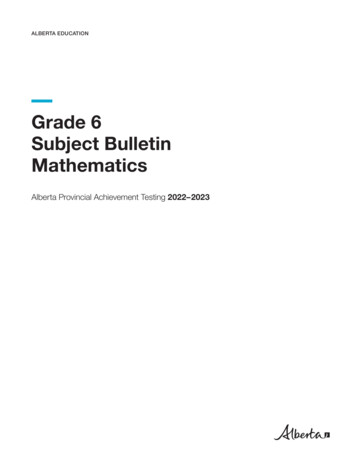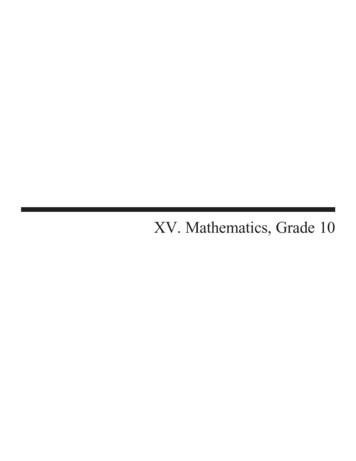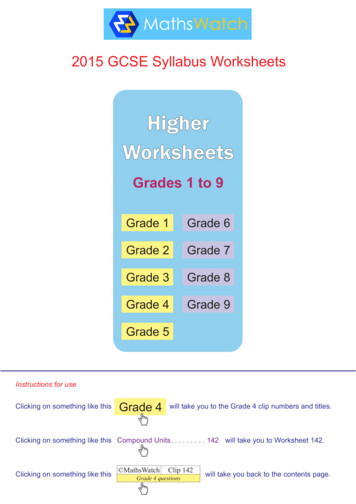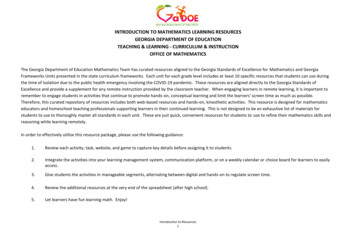
Transcription
ALBERTA EDUCATIONGrade 6Subject BulletinMathematicsAlberta Provincial Achievement Testing 2022–2023
This document was written primarily forStudentsTeachers Administrators Grade 6 MathematicsParentsGeneral Audience2022–2023 Mathematics 6 Subject BulletinDistribution: This document is posted on the Alberta Education website. Copyright 2022, the Crown in Right of Alberta, as represented by the Minister of Education, Alberta Education, Provincial Assessment,44 Capital Boulevard, 10044 108 Street NW, Edmonton, Alberta T5J 5E6, and its licensors. All rights reserved.Special permission is granted to Alberta educators only to reproduce this document for educational purposes and on a non-profit basis.Excerpted material in this document shall not be reproduced without the written permission of the original publisher (see credits, whereapplicable).2022–2023 Mathematics 6 Subject Bulletin Alberta Education, Provincial Assessment
ContentsGrade 6 Mathematics Provincial Achievement Test. 1 General description1 Test administration1Description of Grade 6 Mathematics provincial assessment standards . 2 Use of calculators and manipulatives3 Scoring and reporting3 Blueprints4Preparing Students for the Grade 6 MathematicsProvincial Achievement Test . 5 Suggestions for preparing students5 Special-format practice tests5 Suggestions for answering questions6Opportunities to Participate in Test-development Activities . 7 Field testing7 Working groups7Appendix 1: Levels of Item Complexity. 8Appendix 2: Example of Part A Instructions Pages andExamples of Questions. 9 Example of Grade 6 Mathematics Part A instructions pages9 Examples of Grade 6 Mathematics Part A questions11 Example of Grade 6 Mathematics Part A answer sheet - blank13 Example of Grade 6 Mathematics Part A answer sheet - key14Appendix 3: Example of Part B Instructions Page andExamples of Questions. 15 Example of Grade 6 Mathematics Part B instructions page15 Examples of Grade 6 Mathematics Part B questions16 Low complexity16 Moderate complexity17 High complexity18 Example of Grade 6 Mathematics Part B answer sheet - blank19 Example of Grade 6 Mathematics Part B answer sheet - key20Appendix 4: Examples of Descriptions for Audio Versions of theMathematics 6 Provincial Achievement Test . 21 Units21 Numerical values222022–2023 Mathematics 6 Subject Bulletin Alberta Education, Provincial Assessment
Symbols and notation22 Tables23 Graphs24 Line graphs25 Bar graphs26 Number lines27Contacts 2022–2023 . 28You can find provincial achievement test-related materials on the Alberta Education website. Additional topics of interest arefound in the General Information Bulletin.2022–2023 Mathematics 6 Subject Bulletin Alberta Education, Provincial Assessment
Grade 6 Mathematics Provincial Achievement TestGeneral descriptionThe Grade 6 Mathematics Provincial Achievement Test consists of two parts: Part A consists of 15 numerical-response questions. There are seven addition/subtraction questions and eightmultiplication/division questions. The format of the questions is numerical-response, which requires students to generate aresponse without the use of calculators (in symbolic form) to a particular problem, rather than selecting a response from alist of four options. Each response will consist of a maximum of four digits or, if a decimal point occurs in the answer, threedigits. Examples of these questions are provided in Appendix 2. Part B consists of 40 multiple-choice questions that provide students with four response options, of which only one iscorrect. Examples of these questions are provided in Appendix 3.Questions are categorized according to three levels of complexity: low, moderate, and high. (See Appendix 1 for a moredetailed explanation of each complexity level.)A dictionary, a thesaurus, or other reference materials are not permitted for students writing the test.Test administrationThe Grade 6 Mathematics Provincial Achievement Test Part A and Part B can be written digitally by submitting a request touse the Quest A online test system.Students can take a break between the writing of parts A and B. Students may also write the parts in any order and onseparate days according to the schedule set by the school authority.Part A is designed to be completed in 20 minutes; however, each student may have up to 40 minutes to complete this part,should they need it.Part B is designed to be completed in 70 minutes; however, each student may have up to 140 minutes to complete this part,should they need it.Any Alberta Education blank paper needed for rough work must be provided to students by the supervisor, and collected bythe supervisor at the end of the provincial achievement test administration and returned with test materials to AlbertaEducation. Alternatively, students can prepare their rough work in the provided test booklet.2022–2023 Mathematics 6 Subject Bulletin Alberta Education, Provincial Assessment1
Description of Grade 6 Mathematics provincial assessmentstandardsThe following statements describe what is expected of Grade 6 students at the acceptable standard and the standard ofexcellence, based on outcomes in the Grade 6 Mathematics Program of Studies. These statements represent examples of thestandards against which student achievement is measured. It is important to remember that one test cannot measure all theoutcomes in the Grade 6 Mathematics Program of Studies.Acceptable standardStandard of excellenceStudents who meet the acceptable standard in Grade 6Mathematics are typically able toStudents who meet the standard of excellence in Grade6 Mathematics are typically able to recall and apply a moderate number of mathematicalproperties to solve routine problems recall and apply a variety of mathematical properties tosolve novel problems use familiar problem-solving strategies to solve routineproblems use a variety of problem-solving strategies to solve novelproblems connect and apply personal experiences and problemsolving strategies to solve routine problems connect and apply personal experiences and strategiesto check and verify solutions to novel problems recall and apply mathematical concepts and operationalterms to solve routine problems apply abstract-thinking skills to reframe mathematicalconcepts to solve novel problems apply computation skills and formal mathematicsvocabularies to solve routine problems generate linguistic and non-linguistic representations ofknowledge to solve novel problems recognize and describe numerical and non-numericalpatterns demonstrate fluency in working with patterns representedconcretely, pictorially, or symbolically use semantic knowledge to construct correct mentalrepresentations of word problems use semantic knowledge to construct and reframecorrect mental representations of word problems use logical processes to analyze and solve routineproblems use logical processes to analyze complex problems,reach conclusions, and justify or defend conclusions recognize and use mathematical patterns to makepredictions when solving routine problems recognize, extend, create, and use mathematicalpatterns to make and justify predictions when solvingnovel problems test generalizations from patterns to reach conclusions make generalizations from patterns to reach conclusions22022–2023 Mathematics 6 Subject Bulletin Alberta Education, Provincial Assessment
Use of calculators and manipulativesPart A: Manipulatives may be used, but use of a calculator is not permitted.Part B: Manipulatives and a calculator may be used; however, a scientific or graphing calculator is not permitted. In addition tothe four standard mathematical functions of addition ( ), subtraction (–), multiplication ( ), and division ( ), a calculator is alsopermitted to have the following functions: percentage (%) square root ( ) sign change ( /–) simple memory (M , M–, MC, MR)An acceptable manipulative is any mathematical tool that can be used by a student to help convert abstract ideas into concreterepresentations for the purpose of solving a problem (e.g., a protractor, a ruler, tracing paper, pattern blocks, tiles and cubes,geoboards, tangrams, counters, spinners, number lines). The manipulative cannot perform the mental conversion or providethe solution to a problem. A multiplication table is not an acceptable manipulative for use in completing Part A (except as anaccommodation) or Part B.Scoring and reportingMarking keys will be provided to teachers for marking purposes. Teachers are expected to record and report the raw scoresachieved on the test by their students to parents. Raw scores achieved by students on Part A and Part B are to be reportedseparately to parents and are not to be combined into a total test score.2022–2023 Mathematics 6 Subject Bulletin Alberta Education, Provincial Assessment3
BlueprintsTest ComponentNumber of QuestionsQuestion FormatWeighting on Total TestPart A15Numerical Response10%Part B40Multiple Choice90%Content Domain of Test(Strand)Part A:Percentage of QuestionsPart B:Percentage of QuestionsNumber100%25–35%Pattern20–30%Shape and Space20–30%Statistics and Probability10–20%Cognitive Domain of Test(Complexity Level)Part A:Percentage of QuestionsPart B:Percentage of 5%42022–2023 Mathematics 6 Subject Bulletin Alberta Education, Provincial Assessment
Preparing Students for the Grade 6 Mathematics ProvincialAchievement TestSuggestions for preparing studentsThe best way to prepare students for writing the provincial achievement test is to teach the Mathematics Program of Studieswell and to ensure that students know what is expected. Many of the skills and attitudes that support test writing are, in fact,good skills and strategies for approaching all kinds of learning tasks.Note that most of the questions on the mathematics test are placed in real-life contexts.Teachers are encouraged to familiarize their students with the types of questions that will appear on the test. Releasedmaterials from previously secured tests are available on the Alberta Education website.Teachers are also encouraged to share the following information with their students to help them prepare for the Grade 6Mathematics Provincial Achievement Test.Special-format practice testsTo give students an opportunity to practise provincial achievement test-style questions and content in Braille, audio, largeprint, or coloured print versions, Alberta Education produces special-format practice tests for all subjects that have a provincialachievement test. Alberta schools with registered Alberta K–12 students may place orders for these tests. Braille versions areavailable in English and, by request, in French. All tests are provided free of charge, but limits may be placed on ordervolumes to ensure access for all students.For the greatest benefit, special-format practice tests should be written under conditions similar to those of the correspondingprovincial achievement test. The same rules regarding the use of resources and devices should be followed.Braille versions must be returned to Alberta Education after use.For more information or to place an order, contact Field.Test@gov.ab.ca.2022–2023 Mathematics 6 Subject Bulletin Alberta Education, Provincial Assessment5
Suggestions for answering questions Before you begin, find out how much time you have. Ask questions if you are unsure of anything. Skim through the whole test before beginning. Find out how many questions there are, and plan your time accordingly. Answer the easier questions first; then go back to the more difficult ones. Do not spend too much time on any one question. Make a mark (* or ?) beside any questions you have difficulty with, andgo back to them if you have time. Read each question carefully, underline or highlight key words, and try to determine an answer before looking at thechoices. Read all the choices and see which one best fits the answer. When you are not sure which answer is correct, cross out any choices that are wrong and then select the best of theremaining choices. If time permits, recheck your answers. Double-check to make sure that you have answered everything before handing in the test. Read the information given using the strategy that works best for you. You should either look at all the information and think carefully about it before you try to answer the questionOR read the questions first and then look at the information, keeping in mind the questions you need to answer. Make sure that you look at all forms of the information given. Information may be given in words, charts, pictures, graphs, ormaps. When information is given for more than one question, go back to the information before answering each question. Check your work when you calculate an answer, even when your answer is one of the choices. When answering “best answer” questions, be sure to carefully read all four alternatives (A, B, C, and D) before choosingthe answer that you think is best. These questions will always include a boldfaced qualifier such as best, most strongly, ormost clearly in their stems. All the alternatives (A, B, C, and D) are, to some degree, correct, but one of the alternatives willbe “best” in that it takes more of the information into account or can be supported most strongly by reference to theinformation.62022–2023 Mathematics 6 Subject Bulletin Alberta Education, Provincial Assessment
Opportunities to Participate in Test-development ActivitiesField testingAll provincial achievement test questions are field tested before use. By “testing” the test questions, students who write fieldtests have an opportunity for a practice run at answering questions that could be used on future provincial achievement tests.As well, the teachers have an opportunity to comment on the appropriateness and quality of the test questions.Through the online field-test request system, teachers can create and modify field-test requests and check the status of theserequests. Information regarding the field-test process and the request system is available at Provincial Achievement Tests.Once the completed requests are received by Provincial Assessment, classes will be selected to ensure that a representativeand sufficiently large sample of students from across the province take part in the field test. Every effort will be made to placefield tests as requested; however, because field tests are administered to a prescribed number of students, it may not bepossible to fill all requests.Working groupsTeacher involvement in the development of provincial achievement tests is important because it helps to ensure the validityand appropriateness of the assessments.Teacher working groups are used throughout the test-development process to create raw forms of test questions and to reviewand revise draft forms of provincial achievement tests. These working groups usually meet for one or two days, two or threetimes per year. Occasionally, these meetings are held on weekends.To be eligible to serve on a test-development working group, a teacher must currently be teaching the course in question ormust have taught the course within the past three years.Teachers participating in working groups are selected from the working-group nominees approved by superintendents ofschool jurisdictions. The call for nominations usually occurs in September. However, we will accept further nominationsthroughout the year. In some subjects, more teachers may be nominated for working groups than are needed. When teachersare selected, there must be a balance of first-time and experienced working-group members and regional representation byzone, school authority, and school. Unfortunately, not everyone whose name is submitted will be selected.2022–2023 Mathematics 6 Subject Bulletin Alberta Education, Provincial Assessment7
Appendix 1: Levels of Item ComplexityLEVELS OF ITEM COMPLEXITYLow ComplexityModerate ComplexityHigh ComplexityItems in this category require studentsto rely heavily on recalling andrecognizing previously learnedconcepts and principles. Itemstypically specify what students are todo, which is often to carry out someprocedure that can be performedmechanically. Students would not beexpected to come up with originalmethods for finding a particularsolution. The following list illustratessome of the demands that items oflow complexity may make of students.Items in this category involve moreflexibility of thinking and choice amongalternatives than those in the lowcomplexity category. Moderatecomplexity items require a responsethat goes beyond the habitual, is notspecified, and may require more than asingle step. The student is expected todecide what to do, using informalmethods of reasoning and problemsolving strategies, and to bring togetherskills and knowledge from variousdomains. The following list illustratessome of the demands that items ofmoderate complexity may make ofstudents.Items in this category make heavydemands on students by requiringthem to engage in more-abstractreasoning, planning, analysis,judgment, and creative thought. Thefollowing list illustrates some of thedemands that items of high complexitymay make of students. Recall or recognize a fact, term, orproperty. Solve a word problem requiringmultiple steps. Perform a procedure having multiplesteps and multiple decision points. Recognize an example of aconcept. Compare figures or statements. Analyze similarities and differencesbetween procedures and concepts. Perform a specified procedure. Evaluate an expression in anequation or a formula for a singlevariable. Solve a one-step word problem. Draw or measure simple 2-Dshapes or 3-D objects. Retrieve information from a graph,table, or figure. Provide a justification for steps in asolution process. Interpret a visual representation. Retrieve information from a graph,table, or figure and use it to solve aproblem requiring multiple steps. Interpret a simple argument. Generalize a pattern. Formulate an original problem, givena situation. Solve a problem in more than oneway. Explain and justify a solution to aproblem. Describe, compare, and contrastsolution methods. Formulate a mathematical model fora complex situation. Analyze the assumptions made in amathematical model. Analyze or produce a deductiveargument. Provide a mathematical justification.82022–2023 Mathematics 6 Subject Bulletin Alberta Education, Provincial Assessment
Appendix 2: Example of Part A Instructions Pages and Examplesof QuestionsExample of Grade 6 Mathematics Part A instructions pages2022–2023 Mathematics 6 Subject Bulletin Alberta Education, Provincial Assessment9
102022–2023 Mathematics 6 Subject Bulletin Alberta Education, Provincial Assessment
Examples of Grade 6 Mathematics Part A questions2022–2023 Mathematics 6 Subject Bulletin Alberta Education, Provincial Assessment11
122022–2023 Mathematics 6 Subject Bulletin Alberta Education, Provincial Assessment
Example of Grade 6 Mathematics Part A answer sheet - blank2022–2023 Mathematics 6 Subject Bulletin Alberta Education, Provincial Assessment13
Example of Grade 6 Mathematics Part A answer sheet - key142022–2023 Mathematics 6 Subject Bulletin Alberta Education, Provincial Assessment
Appendix 3: Example of Part B Instructions Page and Examples ofQuestionsExample of Grade 6 Mathematics Part B instructions page2022–2023 Mathematics 6 Subject Bulletin Alberta Education, Provincial Assessment15
Examples of Grade 6 Mathematics Part B questionsLow complexity162022–2023 Mathematics 6 Subject Bulletin Alberta Education, Provincial Assessment
Moderate complexity2022–2023 Mathematics 6 Subject Bulletin Alberta Education, Provincial Assessment17
High complexity182022–2023 Mathematics 6 Subject Bulletin Alberta Education, Provincial Assessment
Example of Grade 6 Mathematics Part B answer sheet - blank2022–2023 Mathematics 6 Subject Bulletin Alberta Education, Provincial Assessment19
Example of Grade 6 Mathematics Part B answer sheet - key202022–2023 Mathematics 6 Subject Bulletin Alberta Education, Provincial Assessment
Appendix 4: Examples of Descriptions Used in Audio Versionsof the Mathematics 6 Provincial Achievement TestThis appendix has been prepared by Alberta Education Provincial Assessment staff. Its purpose is to provide school staff withexamples of the descriptions of diagrams, illustrations, and visuals used in provincial achievement test audio versions, whichare available to students as an accommodation. These examples are neither exhaustive nor prescriptive. Test content isshown in black text and descriptions in blue text.For students who are enrolled with a school, and who typically use audio for their coursework, no application is required toreceive this accommodation when writing provincial achievement tests. Such students may have visual impairments, physicaldisabilities, or learning disabilities. The audio version is used by students in conjunction with a print, digital, or Braille version ofthe test.Units2022–2023 Mathematics 6 Subject Bulletin Alberta Education, Provincial Assessment21
Numerical valuesSymbols and notation222022–2023 Mathematics 6 Subject Bulletin Alberta Education, Provincial Assessment
TablesIntroduce the table starting with the title, if there is one, and then identify the number of columns and rows. Tables can be readin two different ways. One way is to list the column headings and any corresponding units first. Next, read across each rowfrom left to right, stating the column heading before reading the data in each cell. Read empty spaces in tables as “blank.”There is a table with two columns and four rows. The column headings are “Number of People, n” and “Cost, c.”Number of People: two; Cost: fifty-five dollars and zero centsNumber of People: four; Cost: sixty-four dollars and fifty centsNumber of People: six; Cost: seventy-four dollars and zero centsNumber of People: eight; Cost: eighty-three dollars and fifty cents2022–2023 Mathematics 6 Subject Bulletin Alberta Education, Provincial Assessment23
GraphsIntroduce the graph starting with the title, if there is one, and then describe the labels and scales for the horizontal axis and thevertical axis. If there are no marks or scale on the axis, state this. When there are four graphs for each of the multiple-choiceoptions (A, B, C, and D), describe the labels and scales for the similarities between the graphs, such as the horizontal axis andthe vertical axis, and then describe the shape of the line for each of the choices.There is a grid representing the first quadrant of the Cartesian plane. The horizontal axis and vertical axis are scaled from zeroto twenty, marked and labelled in increments of one. Triangle ABC is located on the grid.Point A is located at nine comma fifteen.Point B is located at three comma ten.Point C is located at twelve comma nine.242022–2023 Mathematics 6 Subject Bulletin Alberta Education, Provincial Assessment
Line graphsThere is a line graph titled “Ethan’s Trip.” The horizontal axis is labelled “Time” in hours, scaled from zero to six, marked andlabelled in increments of one. The vertical axis is labelled “Distance travelled” in kilometres, scaled from zero to five hundred,marked in increments of fifty and labelled in increments of one hundred. The dots have been connected in order by straightlines.2022–2023 Mathematics 6 Subject Bulletin Alberta Education, Provincial Assessment25
Bar graphsIntroduce the graph starting with the title, then describe the label for the horizontal axis. List the label for each bar, and thendescribe the label and scale for the vertical axis. Describe the legend if available.There is a double bar graph titled “Track and Field Competition Results.” The horizontal axis is labelled “School” and from leftto right the bars are labelled “Central Elementary,” “École St. Patrice,” “Forest View,” “Summerfield Elementary,” “WalnutGrove,” and “Wandering Creek School.” The vertical axis is labelled “Number of points,” scaled from zero to twenty-four,marked in increments of two and labelled in increments of four.Two bar graphs are shown. A legend shows that the blue bar graph represents 2014 and the red bar graph represents 2015.262022–2023 Mathematics 6 Subject Bulletin Alberta Education, Provincial Assessment
Number linesIntroduce the number line by describing the tick marks and arrows. Identify if it has open or solid, closed circles and theirlocations.There is a diagram of a number line that has arrows at each end with two labelled points indicated by solid, closed circles. Thenumber line is marked and labelled, reading from left to right, negative three, negative two, negative one; and there are seventick marks between each label. Point M is located two tick marks to the right of negative three. Point N is located three tickmarks to the right of negative two.2022–2023 Mathematics 6 Subject Bulletin Alberta Education, Provincial Assessment27
Contacts 2022–2023Provincial AssessmentCheryl Przybilla, Executive DirectorProvincial rvey StablesGr. 9 English Language Arts and Social StudiesKnowledge & Employability (K&E) English Language Artsand Social Studies780-422-2913Harvey.Stables@gov.ab.caGrade 3, 6, and 9 Provincial AssessmentExam AdministrationKelly Rota, DirectorStudent Learning Assessments andProvincial Achievement Testing Program780-427-6204Kelly.Rota@gov.ab.caPascal Couture, DirectorExam French AssessmentNicole Lamarre, DirectorFrench ssment SpecialistsJulia Lee-SchuppliGr. 3 English .ab.caPamela Klebanov, Senior ManagerBusiness Operations and Special Cases780-427-1912Pamela.Klebanov@gov.ab.caAmy Wu, CoordinatorBusiness Coordinator(Field Testing, GED , and Special Cases and es about special cases, provincial achievement testaccommodations, and special-format materials can be sent byemail to special.cases@gov.ab.ca.Renate Taylor MajeauGr. 3 Numeracy (English and quiries about field testing can be sent by email tofield.test@gov.ab.ca.Peggy Lee PetersGr. 3 Francophone and French Immersion ncial Assessment, Alberta Education44 Capital Boulevard10044 108 Street NWEdmonton AB T5J 5E6Robyn PedersonGr. 6 English Language Arts and Social ne: 780-427-0010Toll-free within Alberta: 310-0000Alberta Education website: alberta.ca/educationDenis DinelGr. 6 and 9 Français/French Language Arts780-422-9424Denis.Dinel@gov.ab.caTony CabayGr. 6 and 9 MathematicsKnowledge & Employability (K&E) ncial Assessment mailing addressWorkforce Development Help DeskTelephone: 780-427-5318Email: WFDhelpdesk@gov.ab.caOffice hours:Monday through Friday, 8:15 a.m. to 4:30 p.m.The office is open during the lunch hour.Kelty FindlayGr. 6 and 9 ScienceKnowledge & Employability (K&E) �2023 Mathematics 6 Subject Bulletin Alberta Education, Provincial Assessment
2022-2023 Mathematics 6 Subject Bulletin Alberta Education, Provincial Assessment 1 . Grade 6 Mathematics Provincial Achievement Test . General description The Grade 6 Mathematics Provincial Achievement Test consists of two parts: Part A consists of 15 numerical-response questions. There are seven addition/subtraction questions and eight










